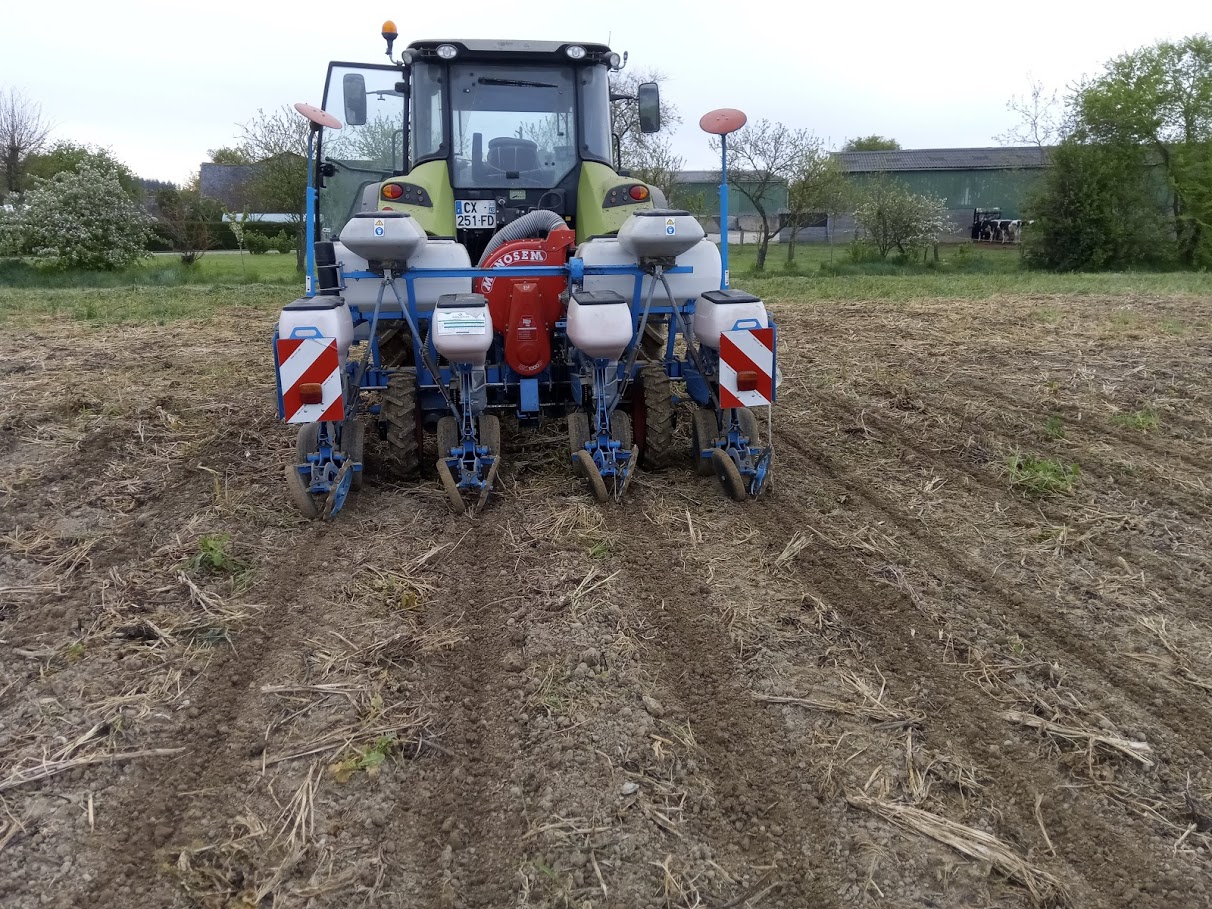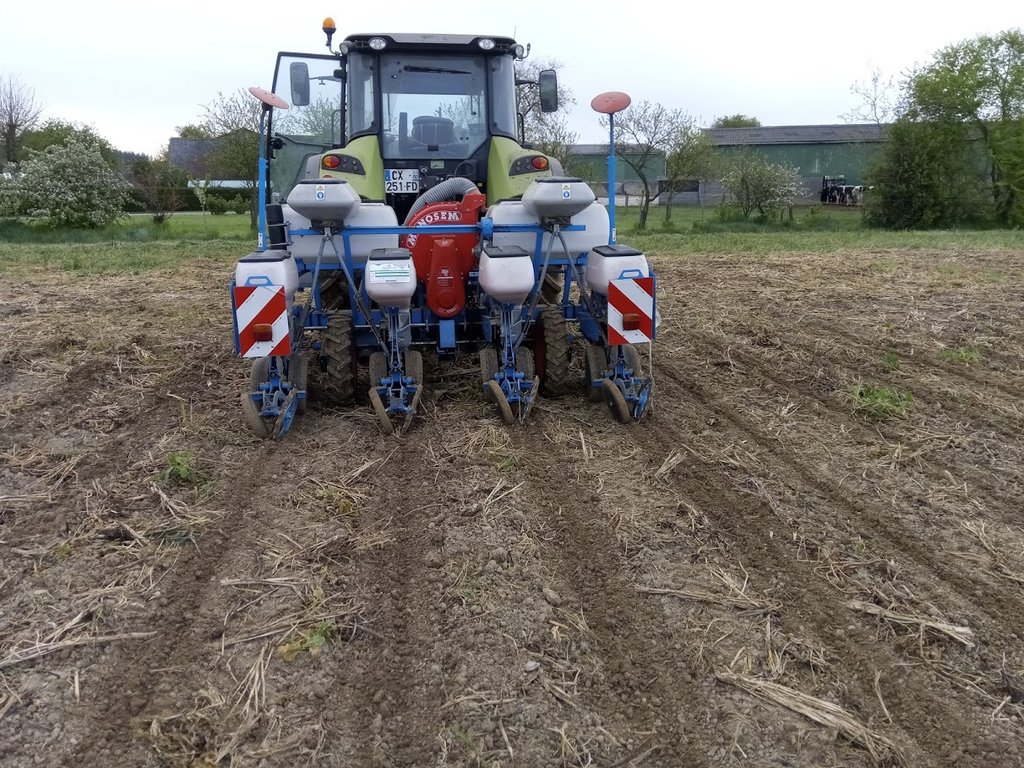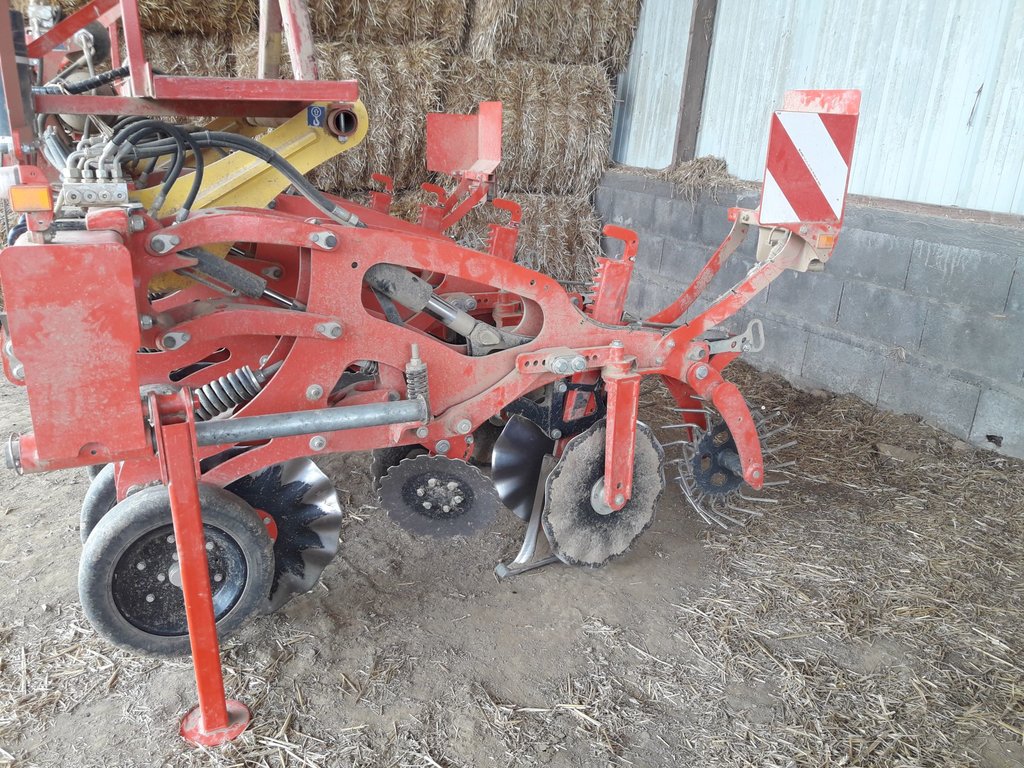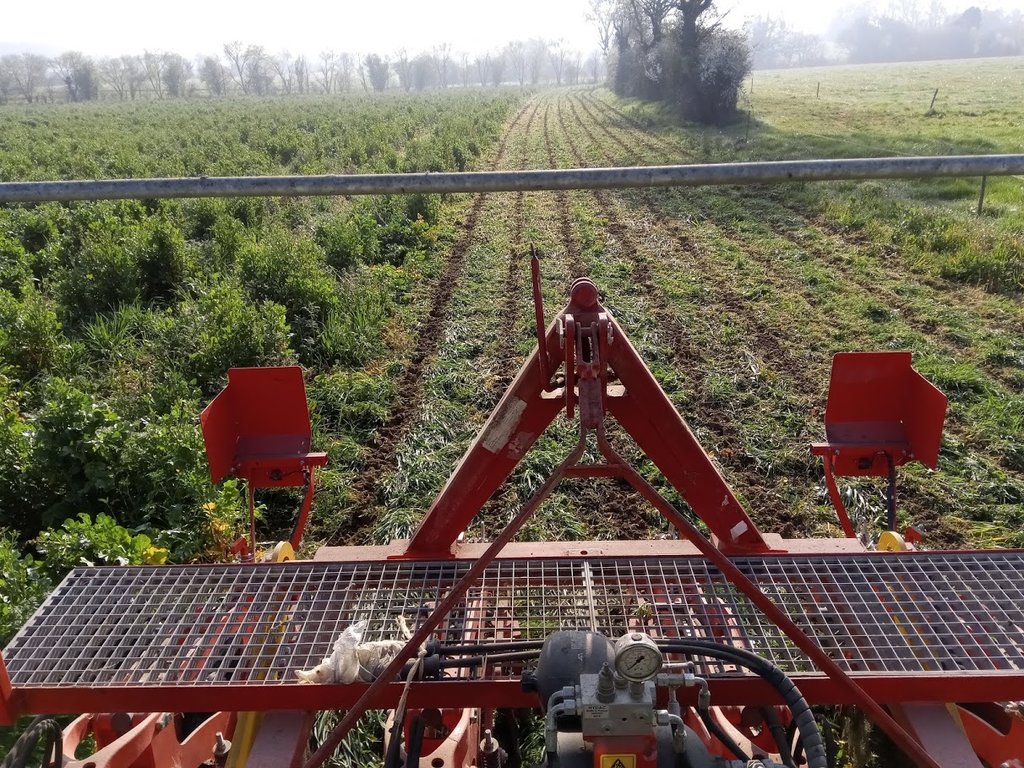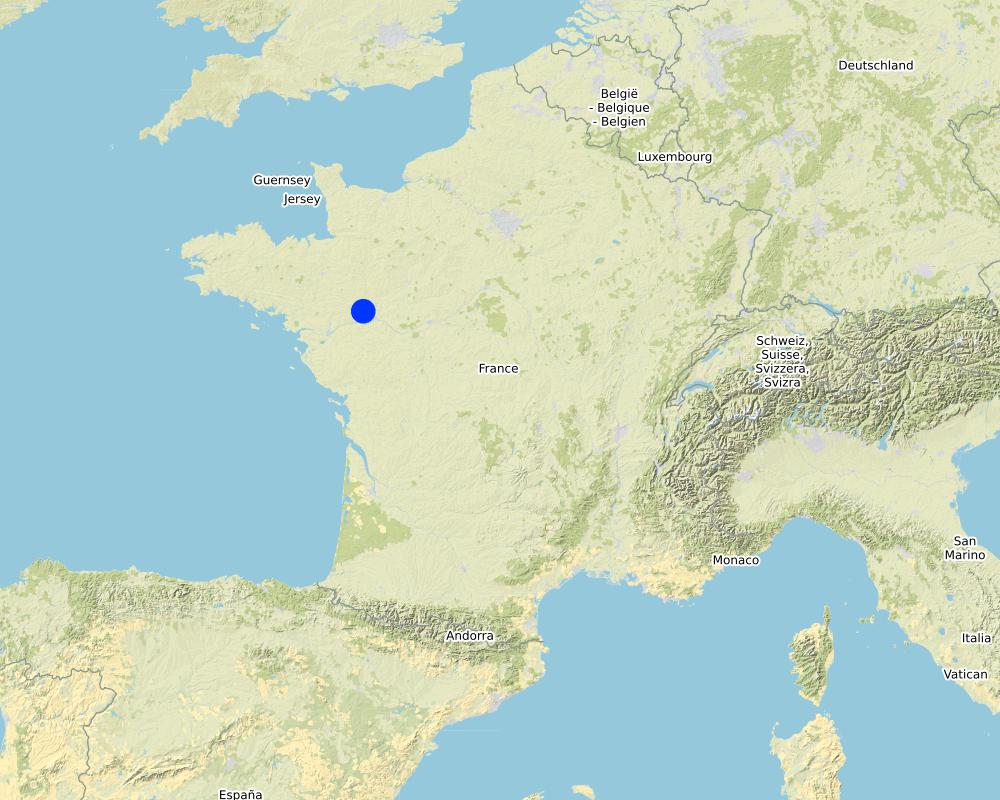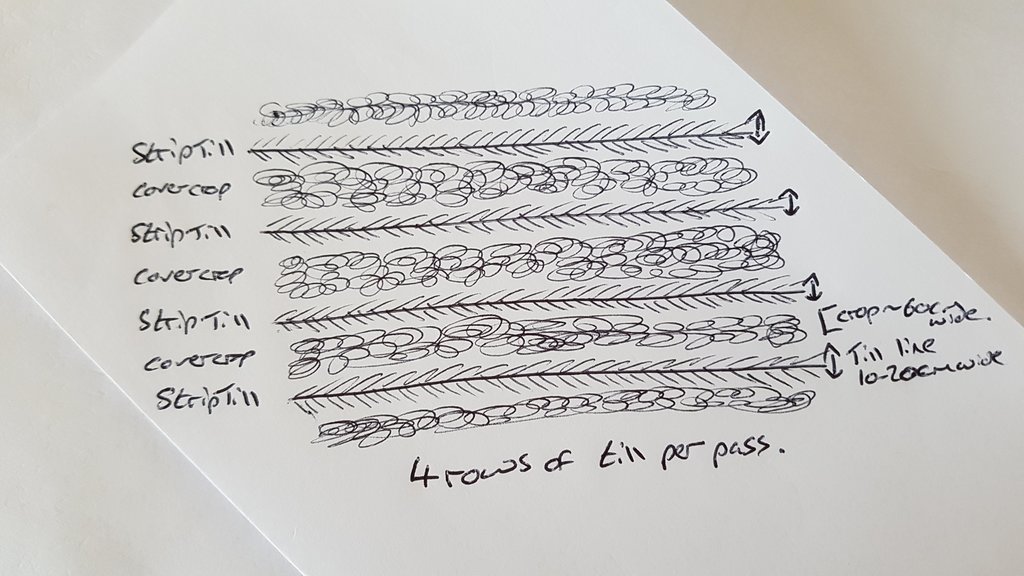Strip till to improve maize establishment [法国]
- 创建:
- 更新:
- 编制者: Alan Radbourne
- 编辑者: David Robinson, David Norris, Sabine Reinsch
- 审查者: Rima Mekdaschi Studer, William Critchley
Strip till
technologies_5676 - 法国
查看章节
全部展开 全部收起1. 一般信息
1.2 参与该技术评估和文件编制的资源人员和机构的联系方式
关键资源人
co-compiler:
Faure Marie-Line
Chamber of Agriculture of Pays de la Loire
法国
土地使用者:
Colineau Denis
Gaec Des Emeraudes
法国
co-compiler:
Drouet Baptiste
Chamber of agriculture of Pays de la Loire
法国
有助于对技术进行记录/评估的项目名称(如相关)
European Interreg project FABulous Farmers有助于对技术进行记录/评估的机构名称(如相关)
UK Centre for Ecology & Hydrology (CEH) - 英国有助于对技术进行记录/评估的机构名称(如相关)
Association des Chambres d’agriculture de l’Arc Atlantique (AC3A) - 法国1.3 关于使用通过WOCAT记录的数据的条件
编制者和关键资源人员接受有关使用通过WOCAT记录数据的条件。:
是
1.4 所述技术的可持续性声明
这里所描述的技术在土地退化方面是否存在问题,导致无法被认为是一种可持续的土地管理技术?:
否
2. SLM技术的说明
2.1 技术简介
技术定义:
Strip tillage to plant maize: a way to reduce soil disturbance and secure maize establishment.
2.2 技术的详细说明
说明:
The region of Pays de Loire in Western France has a temperate climate with warm summers and mild winters. The region has many rural areas, dedicated mostly to agriculture, with large economic centres and conurbations (e.g. the Nantes area). The strip till technology is applied to te same area on a dairy farm in Pays de Loire (La Pouëze), which implements a form of conservation agriculture. Fields have not been ploughed for 9 years, and direct seeding of cover crops (i.e. clover seeded cover for green mulch, weed control and nitrogen fixation) and winter crops (economic cash crop) has been used for 4 years. Crop rotation is practiced on a 2 year rotation between spring maize and winter wheat.
Strip till is a conservation system that uses minimum tillage. It combines the soil drying and warming benefits of conventional tillage with the soil-protecting advantages of no-till by disturbing only the portion of the soil that is to be seeded. Strip till has been developed as an alternative to conventional tillage to prepare the soil before planting maize. It targets tillage on the line to be seeded: on 10 to 20 cm wide strips, at a depth of 10 to 30 cm. Strip till is harder to use in clayey and lumpy soil.
Strip till protects roots and facilitates crop establishment by creating higher soil porosity and seed line warming. As strip till does not disturb the inter-row, soil disturbance is minimized leading to:
-Improved production
-Reduced land degradation
-Beneficial economic impact
Initial investment costs are limited to purchasing the specialised strip till machine, which is about Euro 14,000. Benefits of strip till include:
- Increased: crop production, farm income, water drainage, nutrient cycling, soil organic matter carbon, vegetation cover, beneficial soil species, and habitat diversity
- Reduced: risk of production failure, workload/time, fuel, surface water runoff, evaporation, soil crusting, soil compaction, impact on soil life, and weed emergence
The compilation of this SLM is a part of the European Interreg project FABulous Farmers which aims to reduce the reliance on external inputs by encouraging the use of methods and interventions that increase the farm’s Functional AgroBiodiversity (FAB). Visit www.fabulousfarmers.eu and www.nweurope.eu/Fabulous-Farmers for more information.
2.3 技术照片
2.5 已应用该技术的、本评估所涵盖的国家/地区/地点
国家:
法国
区域/州/省:
Pays de Loire
有关地点的进一步说明:
La Pouëze
具体说明该技术的分布:
- 均匀地分布在一个区域
如果技术均匀分布在一个区域,则指定覆盖的区域(单位为平方千米):
0.3
如果不知道精确的区域,请注明大致覆盖的区域:
- 0.1-1 平方千米
技术现场是否位于永久保护区?:
否
Map
×2.6 实施日期
注明实施年份:
2015
2.7 技术介绍
详细说明该技术是如何引入的:
- 通过项目/外部干预
注释(项目类型等):
Discussions in soil training sessions, trade fairs and farmers' groups
3. SLM技术的分类
3.1 该技术的主要目的
- 改良生产
- 减少、预防、恢复土地退化
- 创造有益的经济影响
3.2 应用该技术的当前土地利用类型
同一土地单元内混合使用的土地::
否

农田
- 一年一作
年作 - 具体指明作物:
- 谷物类 - 玉米
每年的生长季节数:
- 1
采用间作制度了吗?:
是
如果是,说明哪些作物是间作的:
Maize - Cover crops
采用轮作制度了吗?:
是
如果是,请具体说明:
Crop rotation is practiced on a 2 year rotation between spring Maize and winter Wheat
3.3 由于技术的实施,土地使用是否发生了变化?
由于技术的实施,土地使用是否发生了变化?:
- 否(继续问题3.4)
3.4 供水
该技术所应用土地的供水:
- 雨养
3.5 该技术所属的SLM组
- 轮作制度(轮作、休耕、轮垦)
- 最小的土壤扰动
3.6 包含该技术的可持续土地管理措施

农艺措施
- A1:植被和土壤覆盖层
- A2:有机质/土壤肥力
- A3:土壤表面处理
3.7 该技术强调的主要土地退化类型

土壤水蚀
- Wt:表土流失/地表侵蚀

化学性土壤退化
- Cn:肥力下降和有机质含量下降(非侵蚀所致)

物理性土壤退化
- Pc:压实

生物性退化
- Bl:土壤寿命损失
3.8 防止、减少或恢复土地退化
具体数量名该技术与土地退化有关的目标:
- 减少土地退化
4. 技术规范、实施活动、投入和成本
4.1 该技术的技术图纸
技术规范(与技术图纸相关):
The strip till is a machine equipped with:
- 4 teeth permitting soil tillage at a soil depths between 10 cm and 30 cm
- 4 pairs discs to crumble the soil between 10 cm and 20 cm depth for preparation of the seedbed
Between each till line cover crops can be allowed to remain but may be cut back to near soil level to reduce competition with crop seeds.
Technology was applied on 30ha of maize plantation in regular row planting formation.
作者:
Alan Rabdourne
日期:
29/03/2021
4.2 有关投入和成本计算的一般信息
具体说明成本和投入是如何计算的:
- 每个技术区域
注明尺寸和面积单位:
30 ha
如果使用本地面积单位,注明转换系数为1公顷(例如1公顷=2.47英亩):1公顷=:
1 ha = 2.47 acres
其它/国家货币(具体说明):
€
如相关,注明美元与当地货币的汇率(例如1美元=79.9巴西雷亚尔):1美元=:
0.9
注明雇用劳工的每日平均工资成本:
120
4.3 技术建立活动
| 活动 | 时间(季度) | |
|---|---|---|
| 1. | Purchase of strip till plough | one-off purchase in 2015 |
| 2. | Cutting cover crop | pre-planting crop seed |
| 3. | Strip till and seeding | Crop planting |
4.4 技术建立所需要的费用和投入
| 对投入进行具体说明 | 单位 | 数量 | 单位成本 | 每项投入的总成本 | 土地使用者承担的成本% | |
|---|---|---|---|---|---|---|
| 劳动力 | Cover crop cutting | day | 1.0 | 120.0 | 120.0 | 100.0 |
| 劳动力 | Strip till & seeding | day | 1.5 | 120.0 | 180.0 | 100.0 |
| 设备 | Strip till | per till | 1.0 | 14000.0 | 14000.0 | 100.0 |
| 设备 | Tractor (inc fuel) | day | 2.5 | 50.0 | 125.0 | 100.0 |
| 技术建立所需总成本 | 14425.0 | |||||
| 技术建立总成本,美元 | 16027.78 | |||||
4.5 维护/经常性活动
| 活动 | 时间/频率 | |
|---|---|---|
| 1. | Strip till run | Annual |
| 2. | Cover crop management | Annual |
4.6 维护/经常性活动所需要的费用和投入(每年)
| 对投入进行具体说明 | 单位 | 数量 | 单位成本 | 每项投入的总成本 | 土地使用者承担的成本% | |
|---|---|---|---|---|---|---|
| 劳动力 | Cutting cover crop | day | 1.0 | 120.0 | 120.0 | 100.0 |
| 劳动力 | Strip till & seeding | day | 1.5 | 120.0 | 180.0 | 100.0 |
| 设备 | Strip till maintanance | per item | 1.0 | 100.0 | 100.0 | 100.0 |
| 设备 | Tractor (inc fuel) | day | 2.5 | 50.0 | 125.0 | 100.0 |
| 技术维护所需总成本 | 525.0 | |||||
| 技术维护总成本,美元 | 583.33 | |||||
4.7 影响成本的最重要因素
描述影响成本的最决定性因素:
The initial investment to buy the strip till is high, but its cost by passage is lower than ploughing or other simplified techniques of implantation.
5. 自然和人文环境
5.1 气候
年降雨量
- < 250毫米
- 251-500毫米
- 501-750毫米
- 751-1,000毫米
- 1,001-1,500毫米
- 1,501-2,000毫米
- 2,001-3,000毫米
- 3,001-4,000毫米
- > 4,000毫米
指定年平均降雨量(若已知),单位为mm:
650.00
有关降雨的规范/注释:
Mild and rainy winter, hot dry summers (lately)
注明所考虑的参考气象站名称:
Beaucouzé meteorological station
农业气候带
- 半湿润
5.2 地形
平均坡度:
- 水平(0-2%)
- 缓降(3-5%)
- 平缓(6-10%)
- 滚坡(11-15%)
- 崎岖(16-30%)
- 陡峭(31-60%)
- 非常陡峭(>60%)
地形:
- 高原/平原
- 山脊
- 山坡
- 山地斜坡
- 麓坡
- 谷底
垂直分布带:
- 0-100 m a.s.l.
- 101-500 m a.s.l.
- 501-1,000 m a.s.l.
- 1,001-1,500 m a.s.l.
- 1,501-2,000 m a.s.l.
- 2,001-2,500 m a.s.l.
- 2,501-3,000 m a.s.l.
- 3,001-4,000 m a.s.l.
- > 4,000 m a.s.l.
说明该技术是否专门应用于:
- 不相关
5.3 土壤
平均土层深度:
- 非常浅(0-20厘米)
- 浅(21-50厘米)
- 中等深度(51-80厘米)
- 深(81-120厘米)
- 非常深(> 120厘米)
土壤质地(表土):
- 中粒(壤土、粉土)
土壤质地(地表以下> 20厘米):
- 中粒(壤土、粉土)
表土有机质:
- 中(1-3%)
5.4 水资源可用性和质量
地下水位表:
< 5米
地表水的可用性:
中等
水质(未处理):
仅供农业使用(灌溉)
水质请参考::
地下水和地表水
水的盐度有问题吗?:
否
该区域正在发生洪水吗?:
否
5.5 生物多样性
物种多样性:
- 中等
栖息地多样性:
- 中等
5.6 应用该技术的土地使用者的特征
定栖或游牧:
- 定栖的
生产系统的市场定位:
- 商业/市场
非农收入:
- 收入的10-50%
相对财富水平:
- 丰富
个人或集体:
- 个人/家庭
机械化水平:
- 机械化/电动
性别:
- 男人
土地使用者的年龄:
- 中年人
5.7 应用该技术的土地使用者使用的平均土地面积
- < 0.5 公顷
- 0.5-1 公顷
- 1-2 公顷
- 2-5公顷
- 5-15公顷
- 15-50公顷
- 50-100公顷
- 100-500公顷
- 500-1,000公顷
- 1,000-10,000公顷
- > 10,000公顷
这被认为是小规模、中规模还是大规模的(参照当地实际情况)?:
- 中等规模的
5.8 土地所有权、土地使用权和水使用权
土地所有权:
- 个人,有命名
土地使用权:
- 租赁
用水权:
- 个人
土地使用权是否基于传统的法律制度?:
否
5.9 进入服务和基础设施的通道
健康:
- 贫瘠
- 适度的
- 好
教育:
- 贫瘠
- 适度的
- 好
技术援助:
- 贫瘠
- 适度的
- 好
就业(例如非农):
- 贫瘠
- 适度的
- 好
市场:
- 贫瘠
- 适度的
- 好
能源:
- 贫瘠
- 适度的
- 好
道路和交通:
- 贫瘠
- 适度的
- 好
饮用水和卫生设施:
- 贫瘠
- 适度的
- 好
金融服务:
- 贫瘠
- 适度的
- 好
6. 影响和结论性说明
6.1 该技术的现场影响
社会经济效应
生产
作物生产
注释/具体说明:
Efficiency increased in production due to benefit of quicker tillage and benefits of interseedin with cover crops.
生产故障风险
注释/具体说明:
No change in risk.
收入和成本
农业投入费用
注释/具体说明:
Reduced tillage reduces costs
农业收入
注释/具体说明:
Reduced costs leads to greater profit margin
工作量
注释/具体说明:
Significant reduction in the frequency of tool changeover.
生态影响
水循环/径流
地表径流
注释/具体说明:
Due to reduced soil disturbance
多余水的排放
注释/具体说明:
Reduced passages across field, reduces compaction and improves soil water drainage.
蒸发
注释/具体说明:
reduced soil disturbance results in less evaporation
土壤
土壤水分
注释/具体说明:
No change
土壤覆盖层
注释/具体说明:
Reduced disturbance and compaction improves soil cover
土壤流失
注释/具体说明:
Reduced soil disturbance limits soil loss
土壤结壳/密封
注释/具体说明:
Persistance of cover srop and reduced soil disturbance reduces soil cursting potential
土壤压实
注释/具体说明:
Less passages across the field with less equipment use reduces compaction.
土壤有机物/地下C
注释/具体说明:
Reduced soil disturbance allows for improved organic matter development
生物多样性:植被、动物
植被覆盖
注释/具体说明:
Cover cropping persistence with inter-seeding in strips
生物量/地上C
注释/具体说明:
Cover cropping persistence with inter-seeding in strips
有益物种
注释/具体说明:
Cover cropping mix encourages increased beneficial species
栖息地多样性
注释/具体说明:
Cover cropping mix encourages increased habitat diversity
6.3 技术对渐变气候以及与气候相关的极端情况/灾害的暴露和敏感性(土地使用者认为的极端情况/灾害)
渐变气候
渐变气候
| 季节 | 增加或减少 | 该技术是如何应对的? | |
|---|---|---|---|
| 年温度 | 增加 | 好 | |
| 年降雨量 | 减少 | 非常好 |
6.4 成本效益分析
技术收益与技术建立成本相比如何(从土地使用者的角度看)?
短期回报:
非常积极
长期回报:
积极
技术收益与技术维护成本/经常性成本相比如何(从土地使用者的角度看)?
短期回报:
非常积极
长期回报:
积极
6.5 技术采用
- 单例/实验
在所有采用这项技术的人当中,有多少人是自发的,即未获得任何物质奖励/付款?:
- 0-10%
6.6 适应
最近是否对该技术进行了修改以适应不断变化的条件?:
否
6.7 该技术的优点/长处/机会
| 土地使用者眼中的长处/优势/机会 |
|---|
| Reduced soil compaction for maize implantation |
| Reduced drying of the soil that reduces the negative impact on soil biology |
| Makes it possible to locate fertilizer inputs |
| 编制者或其他关键资源人员认为的长处/优势/机会 |
|---|
| Reduced soil compaction |
| Reduced drying of the soil |
| Improved soil health and stability |
6.8 技术的弱点/缺点/风险及其克服方法
| 土地使用者认为的弱点/缺点/风险 | 如何克服它们? |
|---|---|
| Challenging in a lumpy or clayey soil | Take longer to process and implement |
| Complexity of tool settings | The settings are the same once selected |
| 编制者或其他关键资源人员认为的弱点/缺点/风险 | 如何克服它们? |
|---|---|
| Challenging in a lumpy or clayey soil | Take longer to process and implement |
7. 参考和链接
7.1 信息的方法/来源
- 实地考察、实地调查
1 farm example
- 与土地使用者的访谈
1 land user
- 与SLM专业人员/专家的访谈
1 SLM specialist
(现场)数据是什么时候汇编的?:
12/11/2019
链接和模块
全部展开 全部收起链接
无链接
模块
无模块


